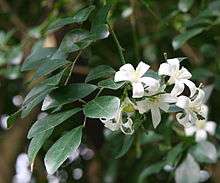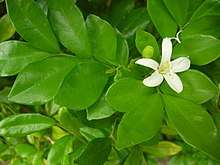Murraya paniculata
Murraya paniculata is a tropical evergreen plant native to South Asia, Southeast Asia and Australia.[2][3][4] The species is widely grown as an ornamental tree or hedge. Murraya is closely related to Citrus, and bears small white flowers followed by small orange to red fruit resembling kumquats, though some cultivars do not set fruit.
| Murraya paniculata | |
|---|---|
 | |
| Foliage and flowers | |
| Scientific classification | |
| Kingdom: | Plantae |
| Clade: | Tracheophytes |
| Clade: | Angiosperms |
| Clade: | Eudicots |
| Clade: | Rosids |
| Order: | Sapindales |
| Family: | Rutaceae |
| Genus: | Murraya |
| Species: | M. paniculata |
| Binomial name | |
| Murraya paniculata | |
| Synonyms[1] | |
| |
Common names
Common names include orange jessamine, Jasmine orange, Chinese box, Atteriya (in Sri lanka), mock orange, mock lime, satinwood or Lakeview jasmine (mainly in Florida). In Brazilian Portuguese it is known as murta de cheiro or jasmim laranja.
Description

Murraya paniculata is a small, tropical, evergreen tree or shrub growing up to 12 meters, but usually remains significantly smaller (typically 2 to 3 meters). The plant flowers throughout the year. Its leaves are glabrous and glossy, occurring in 3-7 oddly pinnate leaflets which are elliptic to cuneate-obovate to rhombic with a smooth or notched edge with a length of up to 5 cm. When grated, the leaves develop a citrus-like smell.
Flowers are terminal, corymbose, few-flowered, dense and fragrant. Petals are 12–18 mm long, recurved and white (or fading cream). The pleasantly fragrant flowers are five-fold with a double flower envelope. The five sepals are ovate to lanceolate with a length of up to 2 mm. The fruit of Murraya paniculata is fleshy, oblong-ovoid, coloured red to orange,[5] and grows up to 1 inch in length.[6]
Range
Native to South and Southeast Asia, China and Australasia, the distribution area extends from Pakistan via India and southern China to Taiwan, the Philippines, the Ryūkyū Islands and the Mariana Islands, to the south via Malaysia and Indonesia to New Guinea and parts of Australia. It is now naturalized in other tropical areas, and as well as southern United States.
The orange diamond grows particularly in thickets and mountain forests (in China it rises to altitudes of 1300 meters). It prefers sunny to lightly shaded locations and tolerates a wide range from acid to alkaline soils .
Uses
Murraya paniculata is used both in traditional medicine as an analgesic and for wood (for tool handles).
It is cultivated as an ornamental tree or hedge because of its hardiness, wide range of soil tolerance (M. paniculata may grow in alkaline, clayey, sandy, acidic and loamy soils), and is suitable for larger hedges. The plant flowers throughout the year and produces small, fragrant flower clusters which attract bees, while the fruits attract small frugivorous birds.[6]
Propagation
The orange jessamine is sexually propagated by its seeds. The fruits are eaten by birds, which then pass the seeds out in their feces. It may also be asexually propagated by softwood cuttings.[6]
Diseases
M. paniculata is vulnerable to soil nematodes, scales, sooty mold and whiteflies.[6]
It is the preferred host to the insect pest Diaphorina citri, the citrus psyllid. This psyllid is the vector for the citrus greening disease.[7]
Gallery
- Flower closeup
 Line drawing showing flowers and fruit
Line drawing showing flowers and fruit Fruits
Fruits Shrubby formation in cultivation
Shrubby formation in cultivation Foliage
Foliage
References
- "The Plant List: A Working List of All Plant Species". Retrieved 8 April 2015.
- Wiersema, John H.; León, Blanca (2013-03-20). World Economic Plants: A Standard Reference, Second Edition - John H. Wiersema, Blanca León - Google Books. ISBN 9781466576810. Retrieved 2016-04-03.
- "Weeds Australia - Weed Identification - Murraya". Weeds.org.au. Archived from the original on 2016-03-03. Retrieved 2016-04-03.
- "Archived copy". Archived from the original on June 2, 2015. Retrieved June 4, 2015.CS1 maint: archived copy as title (link)
- Welsh, 1998; pp 256
- Gilman, Edward F. Factsheet FPS-416, October 1999; University of Florida Cooperative Extension Service, Institute of Food and Agricultural Sciences; from "Archived copy" (PDF). Archived from the original (PDF) on 2007-09-28. Retrieved 2007-06-28.CS1 maint: archived copy as title (link) retrieved on 28 June 2007
- retrieved on 28 June 2007
External links
| Wikimedia Commons has media related to Murraya paniculata. |
- Welsh, S. L. 1998. Flora Societensis: A summary revision of the flowering plants of the Society Islands E.P.S. Inc., Orem, Utah.